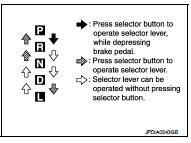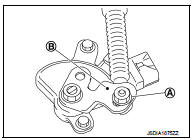Nissan Juke Service and Repair Manual : CVT position
Inspection and Adjustment
INSPECTION
1. Turn ON the ignition switch with the selector lever at the P position.
2. Press the selector button with the brake pedal depressed, and confirm that the lever can be shifted to positions other than P. Also confirm that shifting is not allowed from the P position to other position without depressing the brake pedal.
3. Move the selector lever and check for “excessive effort”, “sticking”, “noise” or “rattle”.
4. Confirm that selector lever stops at each position with the feel of engagement when it is moved through all the positions. Check whether or not the actual position the selector lever is in matches the position shown by the transaxle body.
5. Make sure that the selector lever is shifted to all the shift positions in the manner shown in the figure.
6. When the selector button is pressed without applying forward/ backward force to the selector lever at “P”, “R”, “N” and “D” positions, there should be no “sticking” on the button operation.
7. The reverse lamp lights and the reverse warning buzzer sounds at the “R” position and the reverse lamp does not light and the reverse warning buzzer does not sound at other positions. Confirm that the buzzer does not sound when selector lever is in the “P” or “N” position, in particular, with the lever pushed against the “R” position.
8. Check that the engine can be started with the selector lever in the “P” and “N” positions only.
9. Check that the transaxle is locked when the selector lever is in the P position.

ADJUSTMENT
1. Shift the selector lever to the “P” position.
CAUTION:
Rotate the wheels at least a quarter turn and be certain the Park position
mechanism is fully
engaged.
2. Remove nut (A) and set manual lever (B) to the “P” position.
CAUTION:
Do not apply force to the manual lever.
3. Tighten nuts to the specified torque. Refer to TM-485, "Exploded View".
CAUTION:
In tightening, fix the manual lever.

 Line pressure test
Line pressure test
Work Procedure
INSPECTION
1. Check the engine oil level. Replenish if necessary. LU-25, "Inspection".
2. Check for leak of the CVT fluid. Refer to TM-480, "Inspection".
3. Driv ...
Other materials:
Wiring diagram
NISSAN DYNAMIC CONTROL SYSTEM
Wiring Diagram
For connector terminal arrangements, harness layouts, and alphabets in a
(option abbreviation; if not
described in wiring diagram), refer to GI-12, "Connector Information/Explanation
of Option Abbreviation".
...
Wheel alignment
Inspection
DESCRIPTION
Measure wheel alignment under unladen conditions.
NOTE:
“Unladen conditions” means that fuel, engine coolant, and lubricant are full.
Spare tire, jack, hand tools and
mats are in designated positions.
PRELIMINARY CHECK
Check the following:
• Tires for improper ai ...
Waxing
Regular waxing protects the paint surface and helps retain new vehicle appearance.
Polishing is recommended to remove built-up wax residue and to avoid a weathered
appearance before reapplying wax.
A NISSAN dealer can assist you in choosing the proper product.
• Wax your vehicle only after a t ...

